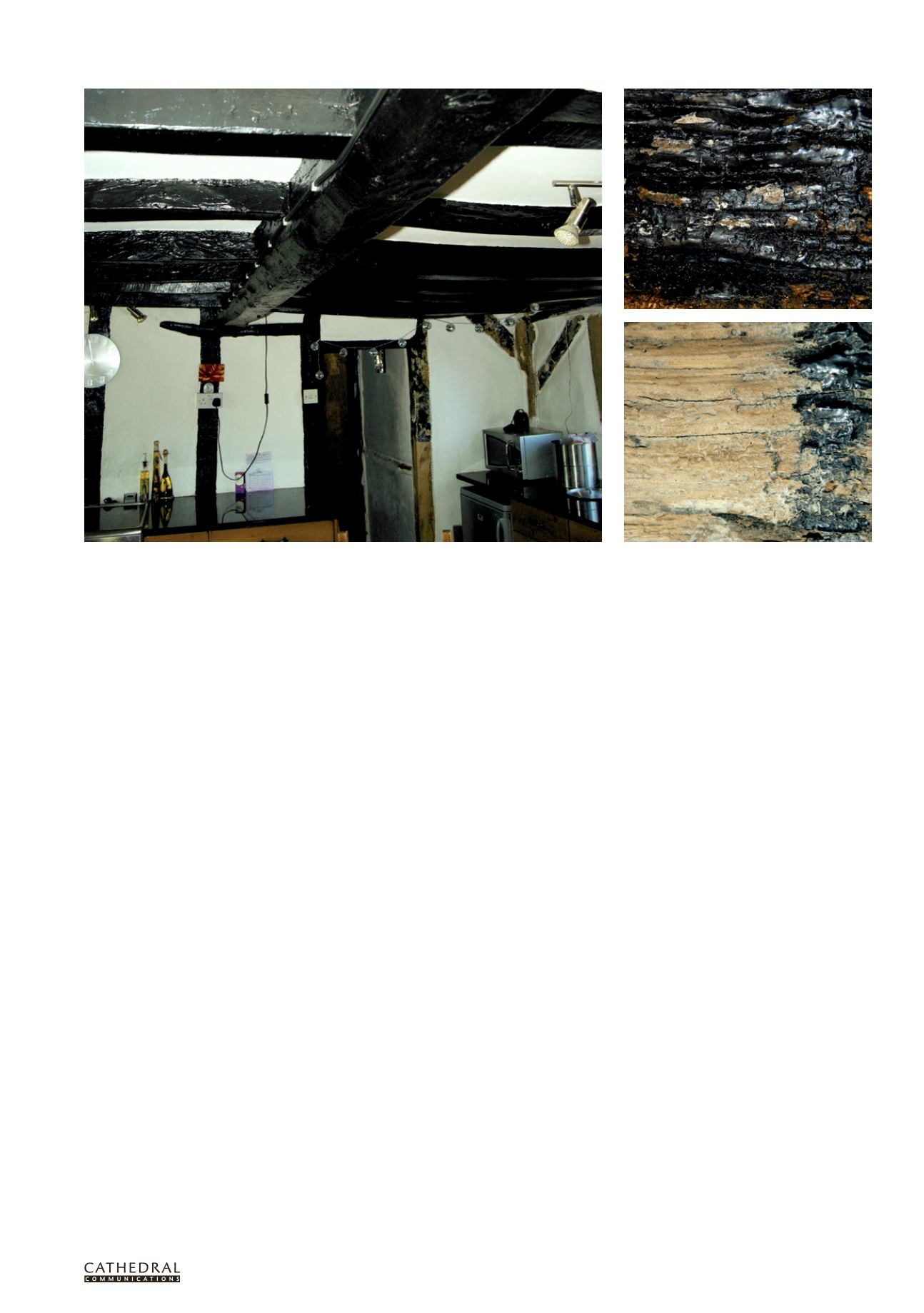

T W E N T Y T H I R D E D I T I O N
T H E B U I L D I N G C O N S E R VAT I O N D I R E C T O R Y 2 0 1 6
1 0 9
3.3
STRUCTURE & FABR I C :
ME TAL ,
WOOD & GLASS
a 19th-century fashion, possibly inspired by
earlier precedents, and that the liquids from
coal and tar deposits were used. However,
closer inspection often shows that the paint
is more modern black gloss. This can give the
timber a dated appearance that seems out
of character with the softer palettes of other
materials in the building.
There is now an increasing desire to
remove this paint to reveal the original timber,
typically internally but sometimes externally
too. This is often a welcome change which
allows the original timber to be seen and it
can dramatically change the character of
the building. It does, however, bring with it a
number of issues and challenges.
The surface of the timber may contain
archaeological evidence of the building’s
construction and development such as
carpenters’ marks, tool marks, ritual marks
and early decorative finishes, often obscured
by many layers of paint.
Even where no archaeological features
exist, the aesthetic value of the surface
should also be considered. The patina and the
presence of a cohesive and unaltered surface
have a value that is easily lost if care is not
taken. Over-aggressive cleaning can cause
irreversible damage to the timber’s surface and
discolouration from chemical cleaning agents
can be difficult to remove without risking
further damage.
The type of wood (hardwood or
softwood), species, rate of growth, type
of conversion and quantity of sapwood
all determine the characteristics of the
timber’s surface and how it will respond
to the various paint removal methods.
If the decision is taken to remove paint,
it is vital that the chosen method ensures
maximum retention of the underlying surface.
PAINT REMOVAL METHODS
Paint removal methods fall into two main
groups: air abrasive and chemical. These are
explored in more detail below.
If the building is listed, the removal
of paint will always require listed building
consent because it changes the character of
the building. There are many horror stories
about poor attempts at paint removal by so-
called specialists which have led to serious
and irreversible damage to the timber. It is a
process that requires careful consideration
and every job will require a different approach.
The nature of the paint and the underlying
substrate should all be taken into account
before choosing a suitable method.
Many conservation officers will resist
any sort of abrasive method (especially
sandblasting) while others will consider
it when presented with a detailed method
statement prepared by a conservation
specialist, and provided the work is carried out
by an experienced contractor. A sample panel
is often required before works can commence.
There is a third option which is becoming
quite popular: repainting the timber to look
like original timber. A few companies offer
this service and wood graining can look quite
convincing. The arguments for and against over
painting are too involved to be explored here
but it is worth noting that this option exists.
AIR ABRASIVE METHODS
Dry abrasive blasting (‘sand blasting’)
In
this method a dry abrasive is fed into a hopper
and a jet of high pressure air with a steady flow
of dry abrasive is directed through a nozzle
against the substrate. The use of dry abrasive
produces a great deal of dust and the spent
abrasive must be cleaned up and disposed of
afterwards.
The type and size of aggregate, flow rate
and pressure can all be varied, as can the
nozzle size, distance from and angle to the
substrate.
Dry ice blasting
In this method solid
CO
2
, which is formed into 3mm rice-like
pellets, is accelerated to supersonic speeds via
a blasting unit and applied using a hand-held
blasting gun through a fragmenting nozzle.
Upon impact the dry ice immediately turns
from its solid state into carbon dioxide vapour
expanding by up to 540 times its volume. The
energy produced by the conversion of solid
to vapour is considerable and is responsible
for much of the cleaning process. The vapour
disappears back into the atmosphere, leaving
only the removed contaminant for disposal.
Wet abrasive blasting
Including a small
proportion of water in the blast results in
less dust than the dry version, so it is easier
to see and control its effect. One system
commonly used by conservation contractors
creates a swirling vortex using a mixture of
low air pressure, a small quantity of water
and an inert fine granulate such as calcium
carbonate. The nozzle cone is interchangeable,
with a larger one for cleaning larger areas and
a smaller one for more intricate detail. The
pressure, type of abrasive and ratio of abrasive
to water can also be varied, as can the distance
from and angle to the substrate.
CHEMICAL METHODS
There are many chemical products on the
market with differing characteristics and
varying degrees of effectiveness depending on
the paint type and substrate being cleaned.
Many of the chemical removers are
applied to the surface in a poultice at 3–6mm
thick according to the thickness of the paint
layers. They are then wrapped in cling film
Typical heavy black gloss paintwork on internal ceiling joists
Timber surface before and after sandblasting
















